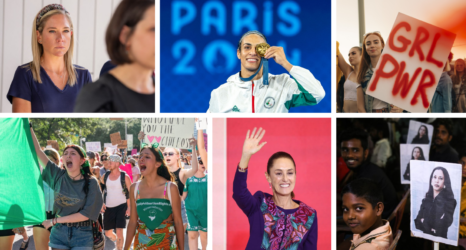
For the last three years, Republican lawmakers at the state level have introduced a slew of bills aimed at regulating the lives of trans children—and less than a month into 2023, they show no sign of stopping. Already, 150 bills aimed at LGBTQIA+ youth have been filed or introduced in 25 states, from restrictions on drag performances, to bans on pronouns teachers can use in the classroom, to mandates that schools ‘out’ trans students to their families. Laws that ban gender-affirming care (the latest: Utah’s Senate Bill 16, which took effect on Saturday, and Mississippi’s House Bill 1125, which passed last week) fly in the face of medical experts.
These discriminatory laws use children a foil in U.S. culture wars. GOP lawmakers and anti-LGBTQIA+ activists say they’re aimed at “protecting children” and the nation’s collective moral future; this argument is nothing new. It’s the same talking point used to bolster white supremacist “racial integrity” laws before the landmark 1967 Loving v. Virginia Supreme Court case, which decriminalized interracial marriage. And during the 2015 Obergefell v. Hodges Supreme Court case, opponents of marriage equality used a similar (il)logic of protecting the “well-being of children.”
As an artist-educator and multiracial Okinawan American queer mom to a nonbinary Jewish child, these issues are both personal and political.
I was a 48-year-old breast cancer patient in 2021 when I came out as queer for the second time.
The first time was in 1986. I was a 13-year-old artsy nerd punk (imagine a half-Asian version of Punky Brewster) in a small-town fundamentalist Christian Pacific Northwest community. I mentioned I was gay to a middle-school classmate—mostly for the shock value, to match my short hair and tomboy fashion, but I did have a vague notion I was attracted to tough girls, pretty boys or anyone resembling Molly Ringwald from 16 Candles.
The rumor spread like wildfire kicking off my welcoming party, with a Monday morning bully slamming me with, “You f****ing faggot!” under a cement stairwell as I was leaving class.
Over 60 percent of LGBTQIA+ students report feeling unsafe at school. Almost 40 percent of them have been physically harassed, and almost 20% have been assaulted. Like many queer youth, I retreated to the closet in my town, before moving across the country to go to The School of the Art Institute of Chicago in 1991.
A lifetime has since passed.
In the last five years of teaching studio art and ethnic studies courses at DePaul University, I’ve seen a marked increase in students using “they/them” pronouns—which my colleague and former student Emily Kraus advocates we embrace in the evolution of gender-inclusive language.
In 2016, when our youngest child came out at age 10 as trans/nonbinary, parenting expanded to include buying safe binders, finding a good therapist and youth support group, learning about medical and non-medical gender-affirming options, and protecting them from getting chased out of bathrooms. While I can’t stop strangers from heckling my child on the street, they have experienced love and acceptance from their friends, family, school, sports, synagogue and Japanese American communities. But I recognize we live in an urban liberal bubble. All kids should be given safety, love and access to gender-affirming education and resources.
In 2017, the personal become political, as the Trump administration began an onslaught of anti-transgender and anti-LGBTQ actions. And today, this state-sanctioned violence continues.

Being in a cisgender, heterosexual monogamous marriage since I was 24 and as a mother to two children now 17 and 29, I didn’t initially feel safe making queerness my home, nor did I feel confident I could economically make it on my own. But this decision left me being a perpetual guest on someone else’s turf. I began to explore queerness through curating and writing about art and the intersections of race, gender, and sexual identity.
I’ve always been queer-adjacent and understood deep down I was some kind of gay, but I didn’t have the language for it. Multidimensional labels like “demi,” “pan,” “femme-tomboi” or “dyke” weren’t a thing in the ’90s as I was coming of age.
After going through breast cancer treatments during the pandemic, I just wanted to be comfortable in my own skin. I was bald from chemo, and my body was a bloated amorphous blob that resembled a daikon radish.
I didn’t feel like performing femininity anymore or hiding queer content I was consuming. I saw a path forward through queer BIPOC disability justice and feminist authors such as Audre Lorde’s groundbreaking 1980 The Cancer Journals and Leah Lakshmi Piepzna-Samarasinha’s 2018 Care Work: Dreaming Disability Justice.
In what I felt self-consciously was my external physical ugliness, I decided to love myself unconditionally. I wasn’t the only one reconsidering sexual and gender identities in pandemic isolation. In a recent survey, the dating app Bumble found that 14 percent of users have shifted their sexual identity since 2020.
To be clear, I’m not saying that people “turn gay” through “social contagion,” as a 2022 study from the American Academy of Pediatrics confirms. I was always gay, but as a classic 1980 study written by Adrienne Rich affirms, I had assumed heteronormativity as a default.
One day in May 2021, just days after completing active treatment for breast cancer, I walked into the kitchen and announced to my husband and then 15-year-old child that I was queer. No one was surprised, but it did impact our family.
Last year on Valentine’s Day week, my husband filed for divorce and, after 25 years of marriage we rang in 2023 by getting amicably divorced. As I’m beginning this new midlife chapter, I am a teacher-turned-student looking to the next generation, including my own child, to learn how we can transform ourselves and our world so we can all thrive.
Up next:
U.S. democracy is at a dangerous inflection point—from the demise of abortion rights, to a lack of pay equity and parental leave, to skyrocketing maternal mortality, and attacks on trans health. Left unchecked, these crises will lead to wider gaps in political participation and representation. For 50 years, Ms. has been forging feminist journalism—reporting, rebelling and truth-telling from the front-lines, championing the Equal Rights Amendment, and centering the stories of those most impacted. With all that’s at stake for equality, we are redoubling our commitment for the next 50 years. In turn, we need your help, Support Ms. today with a donation—any amount that is meaningful to you. For as little as $5 each month, you’ll receive the print magazine along with our e-newsletters, action alerts, and invitations to Ms. Studios events and podcasts. We are grateful for your loyalty and ferocity.





